As it turns out, winter racing is a serious affair if you want to keep your toes and such. Having your gear dialed in, and knowing how to use it, is very important. Here’s a few things I learned, and items I like to use … and this is really not even a remotely complete list of the stuff you really need (or should be thinking about needing at least) for a good winter adventure …
Note that I’m a pack-rat and also not exactly the most experienced winter racer, so you should by no means assume this is a list of any authority. It’s just supposed to give you an idea what worked for me and what didn’t … so far. I’ve got a lot more to dial in, and I think I could go much lighter if I really knew what I was doing …
Mittens: RBH VaprMitts
These are some very bad-ass mittens, and easily my all-time favorite clothing item. They are extremely warm, based on the vapor barrier system, and extremely versatile (I did some research and those do seem like some of the best mittens one can buy, and I wasn’t disappointed). A system of a the mitten shell and various liners worked wonders for me. Usually I start out with the shells (which are extremely thin) dangling from my wrists and gloves. When my fingers get cold, I can slip on the shells. When the temps drop, you can switch from gloves to fleece mittens (Generally I find if things get frosty, gloves make my hands cold). For really low temperatures I use the mid-weight mitten liners from RBH (the hybrid liner) which I ordered with the mitten and which are way hot, and easily kept my hands warm in -20F – I expect to have no problems even much lower. One thing I did is use thin gloves as a third layer. While they don’t add any warmth, they are very useful if you need to take your hands out to do things – a thin glove can extend the time you can operate your fingers considerably (and when it’s very cold, that time can be in the range of minutes). If you’re expecting it to be really crazy cold, the altitude liner from RBH should do the trick. I always bring a number of hand layers, they are light, and it’s essential you have a dry set.
Honorable mention: A nice midweight fleece mitt is the OR PL 400 .
Vapor barrier clothing is an interesting phenomenon. Some love it, some hate it. It works for mittens easily and also for socks. I have a VB shirt, which is a two-edged sword. It is warm, but it’s not fun when it’s wet. You’ll feel cold, but not REALLY cold – it’s uncomfortable but presumably safer because you don’t mess up your insulation layers. I still need to experiment more with those. The RBH website has an explanation of the principles behind VB clothing. It requires a good amount of discipline to use this system optimally.
Jacket: OR Mentor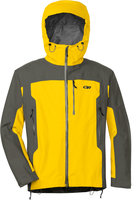
Outdoor experts like Dave Chenault will call bullshit on a waterproof breathable shell in the cold, and to a certain extent that’s right: if it’s cold, breathing doesn’t work well. You always end up with a layer of ice inside your jacket (if not on a lower layer). However, this jacket still has a lot of good going for it:
- In Alaska, especially for multiday adventures, you can hit a wide variety of weather. When it gets warmish, snow or (gasp) rain can happen. This shell is stormproof with sealed everything, and absolutely windproof (which is a feature of the material, GoreTex ProShell).
- It has a good set of pockets which work well with a belt for a sled, since they’re designed to be used with climbing harnesses – same thing. Hold a LOT of stuff. Well placed.
- It has a DOUBLE main zipper (my other Arcteryx jacket doesn’t – booo!). When it’s cold and you want to vent, it’s better to vent down there but keep your throat covered – at least that’s what I feel.
- The side vents go all the way to the hem, so you can use the jacket as a poncho. That rocks! Pit zips don’t usually work well – pain in the ass to operate. These zips rock.
- Adjustability all over, as one would expect – hem, hood. The hood, while helmet-sized, can still be used without and you get a nice high neck, making for some seriously stormproof or wind/cold-fighting prowess.
This is my go-to jacket when the going gets tough. Don’t expect too much in the way of breathability particularly in the cold, but the easy venting more than makes up for that. Why spend $400 for a plastic poncho then, you ask? Because if you look hard and are patient, you may be able to snap one up for <$200, at which point it looks like a good deal – you just don’t get that level of functionality in a simple shell jacket.
Pants: North Face windstopper tights
I got a closeout model. They’re Gore Windstopper fabric pants, and I have to say I’m a big fan of that material. They operate well in an enormous range of temperatures for me – from 40ºF to -20ºF with a 20mph wind (ok they weren’t quite adequate for that, but they kept me going nonetheless without any frost burns of any kind).
Shell: Marmot DriClime Windshirt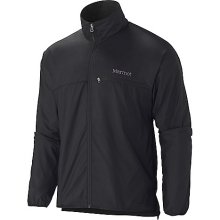
In the winter, the wind is your enemy. Not only does it suck your energy away, but it can make dressing a real pain, since often the wind changes much more significantly and quickly than the actual temps. Having a windblocker lets you not only stay warm, but, if properly layered, you don’t have to adjust as much when the wind picks up. This shirt is light, has a relaxed fit which I really like, and feels great with a lightweight brushed fleece inner layer. Having a layer with a full zipper allows for better venting and access if you put your camelback underneath.
Gaiters: OR Crocodile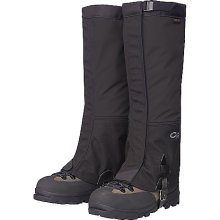
I’ve had good experiences with these – they are waterproof (Gore-Tex, see disclaimer above …), rocksolid, high and keep your legs and feet happy. I believe that Gaiters like these help a lot keeping your toes warm, because they keep your lower legs and ankles warm due to full wind protection (and simply adding a layer there). All major serious Gaiters probably mostly work well, you just should make sure you get the right size and try them out. I would pick high gaiters for longer races.
Cap: Mountain Hardwear Windstopper Micro Dome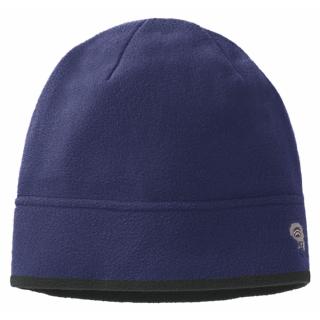
For $14 at Sierra Trading Post this may be the best bang for the buck on this list. It’s warm, windstopper fabric rules, and it’s soft and works well even with wet hair. Very versatile, and it allows you to use the non-windproof fleece balaclava effectively via layering. I also like the peruvian style hats, though they make me sort of deaf.
Balaclava: Seirus Hoodz
This one is surprising. It’s super-comfy, holds up well when accumulating moisture, dries quickly and is very warm. Combined with a windstopper cap or by using the hood on my jacket, it gets me very far in the cold. This balaclava also has an adjustable fit which is useful. I’ve also used:
- Thin under armor balaclava: nice, but once it ices up, restricts your breathing! Doesn’t work when it’s cold. It would seem that’d be the problem with any tightly woven fabric.
- OR Windstopper Gorilla Clava: This is a monster. It has a neat multi-deachable nose and mouthpiece. While it may still find use in harshest conditions particularly with high winds, windstopper material tends to harden up a lot when it gets wet, and the velcro used to attach those pieces makes it hard to really get a good fit – especially when it’s cold and you wear mittens. Still, for very long races, a windblocking balaclava will be part of my gear as well.
But in the end, this pretty cheapo and fairly simple balaclava seems the best to me.
Note: I also have a Turtle Fur fleece neck gaiter (basically a fleece bandanna) and that thing is also seriously awesome when it gets frigid.
Socks: RBH VaprTherm sock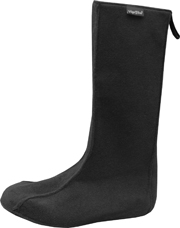
These are some serious vapor barrier socks. They’re quite thick, with a fleece insulation layer on the outside of the barrier, and very warm. The big advantage of these over regular fleece socks, especially when used with waterproof shoes that basically don’t breathe, is that the insulation layer and the shoe stays dry – there’s nothing more of a downer than wet shoes. Use them with some liner socks that work well when wet (like Drymax socks) and add some hydropel and you have one possible system for warm feet. Note though that if your feet are warm depends on a lot of factors – core temp, how cold your legs are, how stiff and tight your shoes are etc.
Baselayer: Skinfit Klima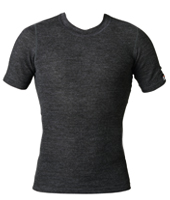
This has been my favorite baselayer for a long time. It feels good when wet and dries very quickly. And it’s made in the Alps 🙂 I also like Craft midweight baselayers, they have similar properties.
Synthetic insulation: Skinfit Caldo Jacket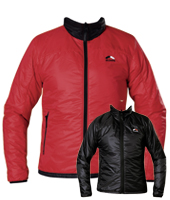
Basically a placeholder for any lightweight primaloft jacket, though Skinfit does its version as usual very well, with a lightweight built-in hood. I also usually bring the Patagonia nano-puff, though the jacket is only marginally heavier and due to the full zip vastly more versatile. If I had to chose, I’d go with the jacket. As is well known, primaloft maintains some insulating properties when wet, as opposed to down, which makes this an important part of my gear list.
Headlamp: Fenix HP-20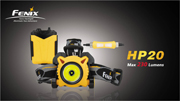
Bit on the pricy side, and slightly heavier compared to it’s small brother, the HP-10 (which outputs the same amount of light). This guy has a number of things going for it:
- Remote battery pack. Keep it warm, hell, put it down your pants. I won’t tell anybody. Even keeping it in the outside pocket of my shell I got 1 1/2 long nights of use out of 4AA batteries (but Energizer Lithiums only).
- Remote on/off/mode switch that has led’s. That one’s really awesome. Don’t fiddle with the lamp on your head, justclick those things. Sweet.
- Bomb-proof. It’s pretty heavy duty.
- Downside: cable mess. Especially when putting the battery pack in your jacket, it makes taking the jacket off a pain.
Also, don’t be a dummy like Steve and always take out the batteries or what I do put a small piece of paper or cardboard in the battery compartment preventing contact of the battery to avoid having the light turn itself on accidentally in your luggage. And then forget to test it before the race … oh Steve. Like a rookie. Honorable mention: Fenix HP-10 – my non-winter headlamp. Great output, great battery life, great price for the performance.
Whatever you bring, use lithium batteries. They’re pricey, but an added bonus is that they only weigh half as much as alkalines (for the AA Energizer version).
Traction: Katoolah Microspikes
These things ROCK. Forget YakTraks – those are useless (fall of your shoes and don’t do well on ice). These things work great on ice, and you can run in them without any worry or issues. They’re not, however, snow traction devices. Ice and very hard-packed snow is the sweet spot. But they fit an enormous range of shoes securely – I was able to put my L size Katoolahs over my insulated size 14 baffin boots which are extremely big. I didn’t bring those for Susitna, since I knew there is no ice to speak of, but I had and used them in the White Mountains, and I used them a lot during training in snow – lifesaver when you hit glare ice.
Shoes: Blahblah GTX
Anyone recommending any specific shoe to you is a liar or dumb, and magazines reviewing shoes are just laughable – it’s just business. Shoes need to suit your foot, the way you run, etc. There are a few things I learned:
- Running shoes are sufficient to keep your feet warm IF you’re moving.
This is in stark contrast to biking, and I attribute this to the fact that your flexing your foot and using your toes to stabilize during running or walking actually entices enough circulation in your feet to keep them warm. Unless your shoes are wet, that is one of the major issues with cold feet, and you can have gigantic boots and still numb toes if there’s no circulation. Some people use light hiking shoes as well, with no problem. For long events, as added security, I will probably bring insulated overboots though. You just never know. - Size up!
I usually size up one size for ultras, but for winter ultras I sized up two sizes. More important than anything is that your shoes are not tight, as any constriction in circulation will make your feet cold. No tight socks, and no overly tight lacing either. Adding sock layers, if they make your shoe tight, won’t do you any good. - Gore-Tex works, sometimes
A Gore-Tex shoe is basically a lined rubber boot in effect. You probably won’t sweat quite as much, but there’s no escaping the fact that they’re just not breathable enough. They work really well in extreme cold, because your feet probably won’t sweat all that much. Protection from occasional overflow and melting ice at the checkpoints is really welcome here. However, they did pose a problem in warm temperatures for me – they got wet inside, and they will stay wet unless you take the time to dry them out. Vapor barrier works for that, but your feet will be wet. That’s something that can be dealt with (Hydropel), but it needs to be taken into account.
As for minimalist running shoes: obviously they don’t work in the cold, I presume even the craziest proponents of those shoes will realize that. But y’all know it’s just a fad, right? There are like a million reasons why it’s bullshit.
Overshoes: Wiggy’s Waders
I haven’t really needed them yet, but they beat plastic bags for protection from overflow and running water. Put on the waders and strap on the Katoolahs and you’re secure, dry and worry-free. Plus they only weigh 9oz, which is a small penalty to pay to avoid potentially toe and race-threatening wet feet! Plus they’re waist-high, which, believe it or not, can be needed!
Down coats: Feathered Friends Hyperion Jacket and Nunatak Torre Parka
Down is the king of warmth. The Hyperion is Jill’s lightweight jacket and it’s wonderfully small, incredibly warm despite just 11oz of weight. I got the Helios, however it is too slim (and most importantly short) a cut – if you get one, order one size up from your normal size. I got the parka for colder and longer adventures and couldn’t really put it fully to the test yet , just as pre-/post-race clothing for White Mountains – however it is insanely warm and has great features:
- Detachable hood
- Cavernous exterior pockets with plenty of down just for the pockets
- Gigantic interior pockets that allow you to store multiple 1l-bottles in your jacket
- Extremely high quality down (875+ fill), and lots of it
The FF jackets are surprisingly not that expensive and I’d pick them over Patagonia or such any day, the Nunatak is made to order and definitely not cheap – but it’s a great piece of equipment, with every detail thought out. Plus the Nunatak is handmade in the USA (the FF ones are made in Canada).
During the Susitna, both Jill and I ended up wearing our FF jackets for parts of the run, and we were glad we had them …
Rain/wind pants: Skinfit Scudo Pant
THE lightest waterproof windproof breathable full-zip pant I could find. Actually the lightest full-zip pant altogether. Again with the breathability, but these are waterproof with waterproof zippers and sealed seams, reinforced in the seat and knee area, with extra zips to allow them to go over boots. Whatever you end up getting (since I gave mine to Jill I am using the cheaper heavier Marmot PreCip pants, which aren’t too bad either) the full zip is really important to me. You don’t want to take your shoes off to put on pants – ever. It’s come in handy in many races, not only winter ones. Also you can unzip to vent, another invaluable feature. Full zip rules.
Nice rundown on your gear, Beat. Uh…thanks for the shout out on the headlamp 🙁
I want to hear more about your views on minimalist shoes (personally I like ’em, but then again my feet aren’t running ultras).
Hehe, you found that little snarky comment!
I am not at all per see against judiciously applied training tools, but the craze and hype that goes along with this trend is annoying me a bit. There are a lot of pseudo-arguments being made that lack any substance (like: we were meant to run this way. We weren’t meant to run on pavement, and I grew up wearing shoes for 40 years – how could one compare my biomechanics with someone who grew up wearing no shoes? And it seems highly non-trivial that I even should change it, now that my growth phase is over. We were also meant to die at age 35). I know that a lot of people jump into this and get stress fractures and other problems because they overdo it … I am certain there are people who can use this very beneficially. But it is obvious that pretty much the industry is in it for a quick buck, and a lot of people don’t know what they’re talking about.
The same can of course be said of super-duper stability shoes and so on. Healthy running requires a lot of discipline, experimentation and IMO staying away from pavement :). Companies offering quick fixes just bug me. Then again, I don’t really care what people do. I am happy with my solid trainers and custom orthotics which I got from a doctor who knows what he’s doing (apparently). It undoubtedly works for my style of running, and I can run a LOT and be fairly happy. There are a lot of factors that contribute to that, and I believe one major reason this works for me is that I don’t intend to go faster, but longer – so I’m fine with low intensity, which in my experience reduces your chance of injuries drastically.
There’s another pet peeve of mine. Often people attribute success to one specific thing they try, neglecting the fact that there are so many factors in one’s success that one person can basically almost never for certain assess if something works or not. There’s a reason we require extensive double-blind studies for medications … It especially bugs me when top runners make such statements, presumably often to make their sponsors happy. It’s misleading.
There’s lots more to be said, but I hope this illustrates my point of view a bit.
Cheers,
Beat
Thanks for expounding – I actually agree with everything you said, even as a VFF wearer.
Beat: Thanks for putting together your list – very helpful!
Beat….excellent list. I learned quite a bit from it. Thanks for taking the time to write it out. One pc I have from your list is the Marmot Driclime windshirt. It’s been my outer layer for biking the last four winters. I wear it daily from September until mid-May in the upper Midwest. I also wore it as my outer layer in the Arrowhead 135. I love that jacket.